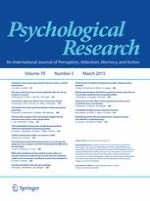01-03-2015 | Original Article
Local feature suppression effect in face and non-face stimuli
Gepubliceerd in: Psychological Research | Uitgave 2/2015
Log in om toegang te krijgenAbstract
There is evidence that the cognitive system processes human faces faster and more precisely than other stimuli. Also, faces summon visual attention in an automatic manner, as evidenced by efficient, ‘pop-out’ search for face targets amongst homogeneous non-face distractors. Pop-out for faces implies that faces are processed as a basic visual ‘feature’ by specialized face-tuned detectors, similar to the coding of other features (e.g., color, orientation, motion, etc.). However, it is unclear whether such face detectors encode only the global face configuration or both global and local face features. If the former were correct, the face detectors should be unable to support search for a local face feature, rendering search slower relative to non-face stimuli; that is, there would be local feature suppression (LFS) for faces. If the latter was the case, there should be no difference in the processing of local and, respectively, global face features. In two experiments, participants discerned the presence (vs. absence) of a local target defined as a part of either a normal or a scrambled (schematic or realistic) face or of a non-face (Kanizsa diamond or realistic house) configuration. The results consistently showed a robust LFS effect in both reaction times and error rates for face stimuli, and either no difference or even a local feature enhancement effect for the control stimuli. Taken together, these findings indicate that faces are encoded as a basic visual feature by means of globally tuned face detectors.
